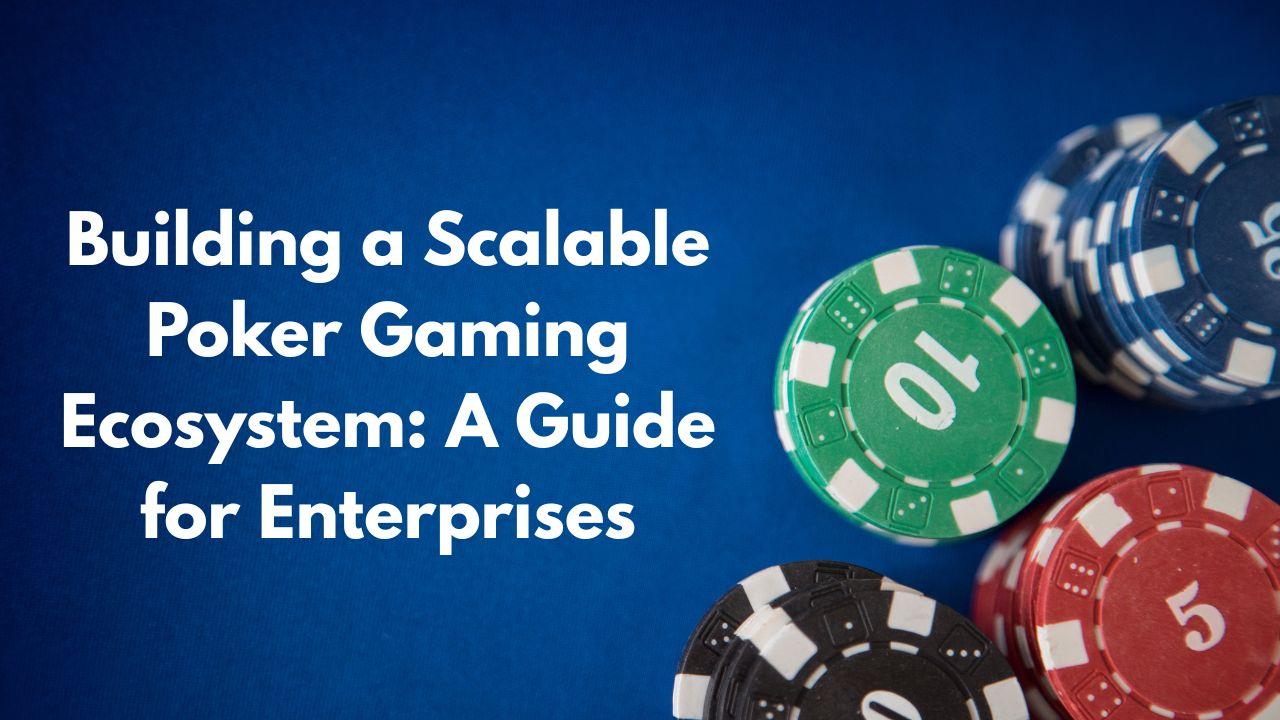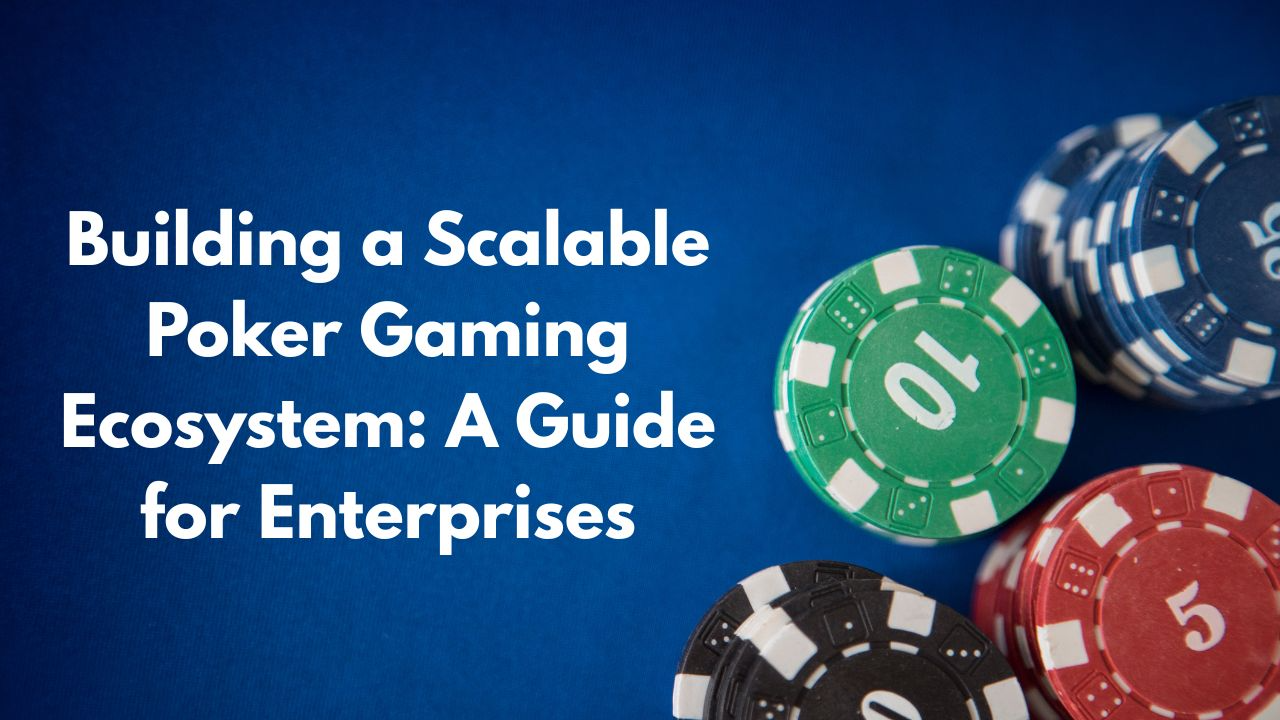A Complete Guide to Building a Scalable Poker Gaming Ecosystem for Enterprises


The world of online gaming, especially poker, has evolved rapidly in recent years. With technology advancing at a fast pace, enterprises now have the opportunity to build scalable poker gaming ecosystems that can grow with the demands of users and the market. But building such an ecosystem involves more than just developing a poker game. It requires a well-thought-out strategy that addresses everything from game design to infrastructure, security, and user engagement. This is where poker game development comes into play, providing businesses the tools to create platforms that are not only engaging but also capable of supporting a growing user base.
In this guide, we’ll take you through the essential steps involved in building a scalable poker gaming ecosystem for enterprises. Whether you’re a startup looking to make your mark in the poker industry or an established business seeking to expand, this guide will help you understand the key factors to consider for long-term success.
Understanding the Need for Scalability in Poker Ecosystems
Before diving into the technical aspects, it’s important to understand why scalability is crucial in building a poker gaming ecosystem. Scalability refers to the ability of the platform to grow seamlessly as the user base expands, without experiencing issues like slowdowns, downtime, or crashes.
Poker games, especially multiplayer versions, require robust infrastructure to handle thousands of concurrent players. A scalable ecosystem ensures that, as your platform gains popularity, you can continue to provide a smooth, uninterrupted experience to users, no matter how many people are playing at the same time.
Some key reasons why scalability matters include:
-
Growing User Base: As your platform attracts more players, a scalable system will help you handle traffic surges without a hitch.
-
New Game Features: Scalability allows you to add new features, poker variants, and functionalities without affecting the existing system.
-
Market Expansion: If your platform expands into new regions or markets, a scalable ecosystem will be flexible enough to handle different languages, currencies, and regulations.
With scalability, you can future-proof your poker gaming ecosystem and ensure it remains competitive for years to come.
Designing a Robust Poker Game Framework
A well-structured poker game framework is the backbone of your gaming ecosystem. You want to design a poker game that is not only entertaining but also capable of handling a large number of players and diverse game types.
Here are a few considerations when designing the framework:
Game Variants
Offering a variety of poker game variants ensures that your platform remains engaging for different types of players. The most popular poker variants include:
-
Texas Hold’em
-
Omaha
-
Seven-Card Stud
-
Razz
It’s also important to consider different types of poker rooms, such as cash games, tournaments, and sit-and-go games. Each of these types requires different backend structures to ensure smooth gameplay, whether players are betting in real time or participating in a long-duration tournament.
Multiplayer Functionality
Poker, at its core, is a multiplayer game. Creating a system that can manage and sync gameplay between players, from card dealing to bet placements, is vital. Look for real-time synchronization to ensure that all players see the same game state at the same time, reducing the chance of glitches and discrepancies.
Virtual Currency and In-App Purchases
In many online poker games, players use virtual chips instead of real money. This requires a secure virtual economy system for transactions, ensuring that players can buy, sell, and trade chips safely. The ecosystem should allow for in-app purchases, allowing users to buy virtual currency, cosmetic items, or even VIP memberships.
Building Scalable Backend Infrastructure
Building a scalable backend infrastructure is the key to ensuring that your poker gaming ecosystem can handle increasing numbers of players and data. The infrastructure should be flexible and efficient, enabling you to scale both vertically (increasing the power of individual servers) and horizontally (adding more servers as needed).
Here are a few important considerations for building scalable infrastructure:
Cloud Hosting Solutions
Cloud hosting platforms like Amazon Web Services (AWS) or Google Cloud provide the ability to scale your infrastructure quickly and efficiently. By using cloud servers, you can easily increase or decrease resources based on traffic, ensuring that your platform is always running at optimal performance.
Load Balancing
Load balancing ensures that traffic is distributed evenly across multiple servers, preventing any single server from becoming overloaded. By using auto-scaling features in the cloud, your infrastructure can automatically adjust based on the number of players online.
Distributed Databases
As the number of players and game sessions increases, managing game data and user information becomes increasingly complex. Distributed databases like MongoDB or Cassandra allow for more flexible data storage, ensuring fast read and write speeds, even when handling a large volume of transactions.
Enhancing User Experience (UX) and User Interface (UI)
In the competitive world of online poker, user experience (UX) and user interface (UI) design play a pivotal role in retaining players and increasing engagement. A smooth, intuitive interface and engaging experience will ensure that players keep coming back to your platform.
Here are some tips for creating a great UX/UI:
Mobile Optimization
The majority of online poker players now prefer to play on their mobile devices. Ensure that your poker game is fully optimized for mobile, offering the same seamless experience whether the user is on a smartphone, tablet, or desktop. Responsive design is key, making sure that the game scales correctly across different screen sizes.
Fast Load Times
Speed is crucial in online gaming. Slow load times can frustrate players and lead to high bounce rates. Ensure that your platform is lightweight, and the game loads quickly, even during peak hours.
Easy Navigation
The design should be simple and easy to navigate. Players should be able to find tables, make bets, and interact with other users with ease. Avoid clutter and keep the design clean.
Ensuring Security and Compliance
Security is one of the most important aspects of any online gaming platform. In the poker gaming world, this is especially true as players are interacting with virtual currency, personal data, and other sensitive information.
Secure Payment Systems
Whether your players are making deposits or withdrawals, secure payment gateways are essential for preventing fraud and ensuring that players feel confident using your platform. Integration with trusted services like PayPal, Stripe, or cryptocurrency wallets can help build trust with your users.
Data Encryption
Make sure that all data, including user information and in-game transactions, is encrypted with SSL certificates. This will prevent any unauthorized access to sensitive data.
Legal and Regulatory Compliance
Every region has its own set of regulations when it comes to online gambling. Ensure that your platform complies with local gambling laws and has the necessary licensing for the markets you wish to target. This will not only protect your business but also provide players with the confidence that they are using a trustworthy platform.
Player Engagement and Retention
Attracting players to your poker ecosystem is only half the battle. Retaining them is where the real challenge lies. Engaged players are more likely to return, invite friends, and spend money on your platform. To create a successful ecosystem, collaborating with experienced poker game developers can help you integrate features like personalized rewards, social elements, and innovative gaming mechanics to keep players engaged and coming back for more.
Loyalty Programs
Loyalty programs, such as VIP rewards, tournaments, and daily missions, can keep players coming back. Offering personalized incentives based on a player's activity helps create a sense of community.
Social Features
Poker is a social game. Allow players to interact with each other through chat rooms, friends lists, and leaderboards. Social features can increase engagement and encourage players to return to the platform.
Gamification
Incorporating gamified elements like achievements, progress bars, and challenges can enhance the overall player experience. It makes the game more engaging and gives players a reason to keep coming back.
Future-Proofing Your Poker Ecosystem
The gaming industry is constantly evolving, and it’s important to stay ahead of trends to ensure that your poker gaming ecosystem remains competitive.
Emerging Technologies
Look into how artificial intelligence (AI) and blockchain can improve your platform’s functionality. AI can be used for things like personalized experiences, while blockchain can offer benefits such as transparent transactions and decentralized gaming.
Continuous Improvement
Don’t settle for the first version of your platform. Regularly update the system, introduce new poker variants, improve game mechanics, and keep refining the user experience.
Conclusion
Building a scalable poker gaming ecosystem for enterprises is no small feat, but by focusing on a well-designed framework, secure infrastructure, strong user experience, and ongoing engagement, your platform can thrive. By investing in a flexible, secure, and scalable system, you’ll ensure that your poker game grows with your user base and stands the test of time.
By keeping these considerations in mind, you’ll not only create a platform that meets the current demands but is also future-proof and ready to evolve with the changing landscape of the online poker world.
- Art
- Causes
- Crafts
- Dance
- Drinks
- Film
- Fitness
- Food
- Jogos
- Gardening
- Health
- Início
- Literature
- Music
- Networking
- Outro
- Party
- Religion
- Shopping
- Sports
- Theater
- Wellness



